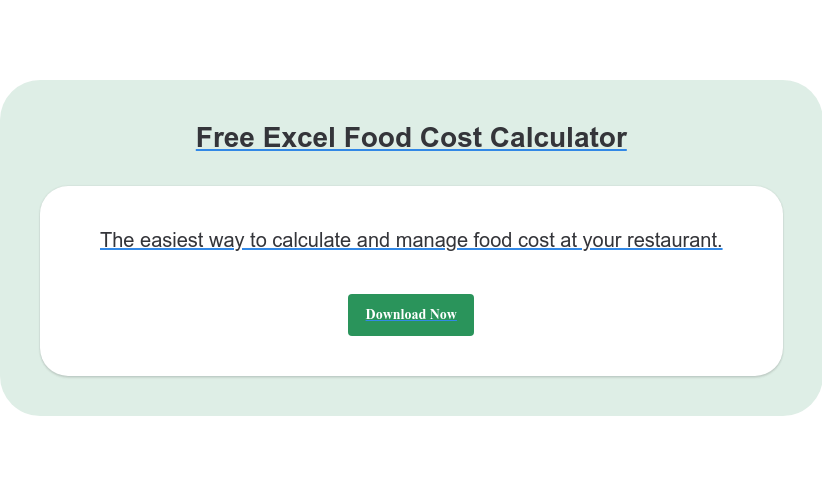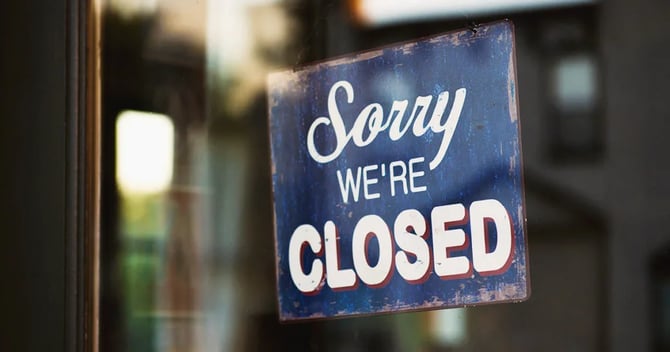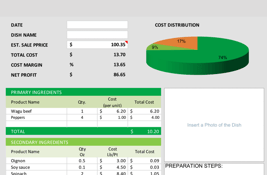One of the great things about the restaurant industry is its low entry barrier. Practically anyone with enough money and the right permits can open a restaurant, anytime and anywhere.
Heading to the exit door, however, can be equally as easy.
Opening a restaurant is one thing but running a successful one is a different story altogether.
Restaurant failure rates as not as high as the ‘90% of restaurants fail within their first year’ myth would have you believe. As a study published on Cornell Hospitality noted, real data aside, it’s a matter of common sense: if that many restaurants really closed for business, they would be declared extinct within a few years. The actual failure rate is still quite high, though: around 30% for the first year and 60% by the third one.
In fact, the topic of restaurant failures is not quite straightforward. When a restaurant closes its doors or changes management, it's not always because of bankruptcy but also due to the owner's personal reasons. And when restaurants do indeed fail, it's not always from bad management. As the Covid-19 pandemic proved, external factors can still prevail over otherwise successful operations.
With all that said, many restaurants still fail simply because customers prefer to eat elsewhere, and they don’t make enough money. When that happens, it’s usually for one or more of these reasons.
The 8 most common reasons restaurants fail
1. Poor leadership and lack of experience
A lot of new restaurant owners enter the food and beverage industry with little to no knowledge of the industry, but rather a desire to fulfill a longtime dream. For the inexperienced, owning a restaurant can seem like a simple task. In fact, it’s the furthest thing from a cookie-cutter job.
Unlike most businesses, restaurants are systems made up of people with very diverse skills roles, so strong leadership is essential to make them work together. When that is lacking, everything else will come crumbling down.
The best leaders in the restaurant industry are usually those who started from the bottom and worked their way up the chain of command. That’s not to say that a newfound restaurant owner won’t be able to handle the task, but it’s going to take a lot more work and a good dose of humility.
2. Not enough capital
One of the main reasons why so many restaurants fail during their first year is that they don’t have enough money to start with.
Many new owners believe they just need enough for the location, staff, equipment and food, and that after opening the business will start generating profit right away.
Quite often, however, it takes time to attract enough customers and create a base of regulars. Without enough capital to get through the building phase, a restaurant is doomed to fail, even if it has all it takes to succeed.
3. Out of control costs
In a typical restaurant there is more to account for financially than for other small businesses, so keeping food cost and labor cost under control isn’t optional. If you’ve been doing it wrong (or not doing it all), you may be leaking money without knowing it. Consider hiring an in-house accountant or an accounting firm to help you. This will get your finances in order and also free up more time to focus on managing the restaurant.

4. Bad food and service
Diners may forgive restaurants for many things, but not bad food and poor service. Once your establishment develops a reputation for this , it’s pretty much game over.
Customers who had a bad experience in a restaurant will spread the word to everyone they know (or don’t know) with online reviews. While most of the other problems can be fixed within a short time span, a bad reputation is one that takes a lot longer to repair.
How you handle a complaint is also a huge factor that determines what customers think about you. For example, instead of insisting the customer is wrong when they send food back to the kitchen, offer a complimentary dessert as an apology. A nice gesture will go a long way in the restaurant industry.
Poor service often stems from lack of a clear chain of command, or from hiring the wrong people. A few bad or demotivated employees are all it takes for a restaurant to start haemorrhaging cash.
5. Bad location
When we talk about a good location for a restaurant, we often think of foot traffic, no similar restaurants nearby and a large enough parking space. While these factors are all very important, there are others to consider.
Population. Are the number potential consumers in the area adequate to sustain business? Is there more potential for high levels of transient, or more regular customers?
Local economy. Do potential customers have the financial ability to dine at your establishment? Also, what is the overall economic outlook for the community? What are the economic history and trends of the past years?
Selecting the wrong location doesn’t necessarily mean that you have to open somewhere else (it probably wouldn’t be easy anyway). However, you may have to change your restaurant concept to adapt.
6. Lack of clear concept
The study mentioned above found out that while many failed restaurants had elaborate strategic plans but no clear concept, those with clear concepts were more successful, even without a clear strategy. What’s more, a concept goes beyond food, including “an operating philosophy, which encompasses business operations as well as employee and customer relations.”
So, if they ask you what your restaurant concept is and all you can talk about is your food, it’s a sign that you have to go back to the drawing board and define your values and mission.
7. Too much competition
Conventional wisdom says that opening up a new pizza place beside an existing pizza place would be a bad idea. But, as we said in the previous point, if your business concept is unique enough, that may not be at all important.
Still though, it’s important to know your competition and study consumer trends in your local area. Understand what the competition offers and be honest with yourself about what you have to offer.
More generally, competition is usually a double-edged sword, so it’s hard to pinpoint exactly what the most optimal conditions are. While it will impact your business one way or another, it’s also a healthy thing to have for a budding business. It has the potential to increase foot traffic, incentivize innovation and possibly create a community invested in the restaurant industry.
Related content: Restaurant Target Market: Find and Understand your USP
8. Too little marketing
Let’s say you keep your costs under control, you have a great location a unique concept and outstanding food and service.
Unfortunately, that may still be not enough for your restaurant business to thrive.
After all, even if you’re doing everything right, so are many of your competitors. So why should diners choose you when they have so much choice?
In a world saturated with restaurants, the only way for yours to stand out is marketing. A strong marketing campaign may be the difference between an empty restaurant at peak hours and one that is on a wait.
Marketing may seem like a costly venture, but when done right, it should provide a more than adequate return on investment.

How to save a failing restaurant
If you feel your restaurant is failing, all hope is not lost. There are a few things you can start doing today.
1. Deep dive on metrics. You can’t know what you can’t measure. There are a lot of restaurant metrics that can tell you where your biggest problems are. For example: food cost, recipe cost, staff turnover rate, labor cost, profit margin, food waste, and customer satisfaction. If you don’t know how to measure them, hire a consultant to help you.
2. Read all of your reviews and respond to negative ones. Don’t take negative reviews only as a nuisance but as an opportunity to improve. Also, don’t limit yourself to reviews that guests leave online, ask them directly. Offer incentives to take surveys, to rate everything from menu items to service.
Related content: 11 Best Questions to Ask in a Restaurant Survey (and how to ask them)

3. Market your restaurant consistently. Marketing for restaurants goes beyond just advertising on social media. Dedicate a couple hours at the start of every month to come up with a simple marketing plan for the remainder of the month. This can include everything from running ads to hosting events at your restaurant.
Related content: 30 Best Restaurant Marketing Strategies
4. Invest in restaurant tech. If you haven’t done it already, it’s time to inject more technology into your business. The hospitality industry is constantly growing and evolving, and if your restaurant isn’t keeping up with the trends, you might get left behind in favor of more tech savvy businesses. From point of sales to inventory management, there are much better approaches to conventional business practices that can save your employees time and money and help you generate more revenue from online bookings.
5. Partner with a restaurant reservation provider. In the short term, this can be a quick way to expose your brand to a larger audience, especially if you need customers right now. The downside however, is that you’re going to be charged for each cover they send your way.
6. Verify your restaurant on Google. A better long-term solution is to work with a provider that is also a Google partner (like Eat App), that can help you generate more online direct reservations.
Google is one of the best ways for potential customers to discover your restaurant. Verify your restaurant and make sure that all information is up to date. If you accept online reservations, add the reservation link to your Google profile to increase the likelihood that someone will make a reservation after discovering your restaurant on Google.
Related content: How to Get More Restaurant Reservations with Google

7. Improve your CRM. When it comes to running a restaurant, good customer relationship management is just as important as the food you serve. Take the necessary steps to understand your customers and restaurant. Know which days of the week are the best performing and where there is room for improvement. By creating a positive ecosystem, customers are more likely to return.
8. Be ready for change. Once you’ve identified where your problems come from, be ready to change. Change the menu to reduce food costs, hire better staff, pay them more and improve training, change decor, define your concept and values, or change it altogether.














.webp?width=200&name=v2-15mknc-qpw1b%20(1).webp)
.webp?width=200&name=v2-15kqni-p0exl%20(1).webp)
-1.png?width=1812&height=1072&name=TripAdvisor%20%26%20More%20Bookings%20(1)-1.png)
-2.png?width=1812&height=1072&name=Google%20Bookings%20(1)-2.png)


-1.png?width=200&name=TripAdvisor%20%26%20More%20Bookings%20(1)-1.png)
-2.png?width=200&name=Google%20Bookings%20(1)-2.png)
-1.png?width=200&name=Instagram%20Bookings%20(1)-1.png)
-1-png.webp?width=200&name=Facebook%20Integration%20Rectangle%20(1)-1-png.webp)







.webp?width=200&name=download%20(1).webp)
%20(1)-2.webp?width=200&name=Eat%20(34)%20(1)-2.webp)
%20(1)-2.webp?width=200&name=Eat%20(18)%20(1)-2.webp)








%20(1)-1.webp?width=314&height=175&name=Eat%20(62)%20(1)-1.webp)


.webp?width=144&height=72&name=Eat%20App%20Logo%20(3).webp)